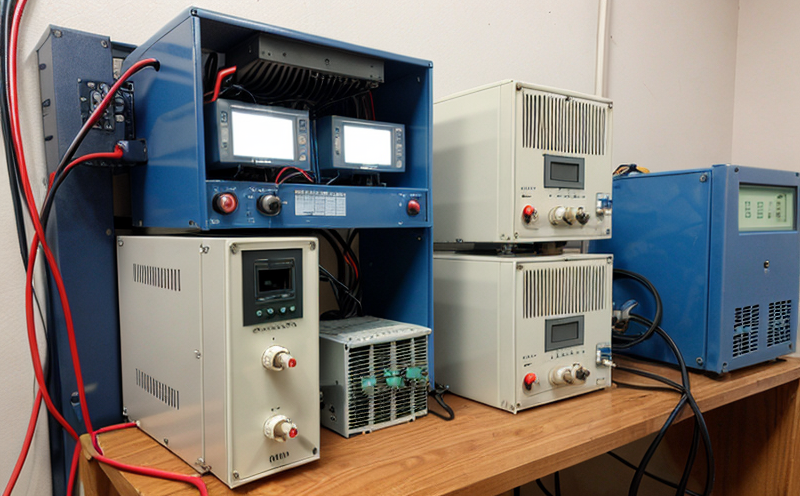UIC 554 Testing of Electrical Supply Systems for Rolling Stock
The UIC 554 standard is one of the most stringent and internationally recognized tests for electrical supply systems in railway rolling stock. This test ensures that power distribution, control, and safety systems are reliable under all operating conditions. Compliance with this standard is essential for ensuring passenger and crew safety as well as minimizing the risk of system failures during operation.
UIC 554 testing involves a series of comprehensive tests designed to evaluate the electrical supply system's performance in various scenarios. These tests include voltage checks, current measurement, insulation resistance assessment, and dielectric withstand testing among others. The standard also covers environmental stress tests like temperature cycling and humidity exposure which simulate real-world conditions.
One of the key aspects of UIC 554 testing is its emphasis on redundancy and fault tolerance within the electrical supply system. This ensures that even if part of the system fails, critical functions can still be maintained to prevent breakdowns during transit. Another important factor is the ability of the system to handle overloads safely without causing damage or compromising safety.
Compliance with UIC 554 not only enhances operational reliability but also plays a crucial role in reducing maintenance costs and downtime for railway operators. By identifying potential issues early on through rigorous testing, organizations can take preventive measures that extend the lifespan of their rolling stock's electrical components.
In summary, adhering to the stringent requirements set forth by UIC 554 helps ensure robustness and longevity of electrical supply systems in railway vehicles. It supports safer operations while enhancing overall efficiency and reducing lifecycle costs for operators.
Why It Matters
The importance of UIC 554 testing cannot be overstated when considering the safety and reliability of modern rail transport systems. Railways are complex networks that rely heavily on electrical power to function efficiently. Any failure in the supply system could lead to significant disruptions, endangering both passengers and staff.
- Enhanced Safety: UIC 554 ensures that all components involved in delivering electricity are capable of handling peak loads safely without risking passenger safety.
- Reliability: By simulating various stress conditions, this testing helps identify weak points early before they become critical issues during actual operations.
- Economic Benefits: Preventative maintenance recommended by these tests can save substantial amounts of money compared to reactive repairs after incidents occur.
The standard promotes best practices for designing and manufacturing electrical systems that meet stringent quality standards. This reduces the likelihood of failures during critical phases such as startup, acceleration, braking, or emergency power supply situations. Ultimately, meeting UIC 554 requirements contributes significantly to maintaining high levels of service availability and passenger comfort.
Why Choose This Test
Selecting the appropriate testing protocol is critical for any organization involved in railway infrastructure development or maintenance. For those seeking assurance about the integrity and performance capabilities of their electrical supply systems, UIC 554 provides peace of mind by offering a robust framework encompassing multiple types of tests.
Firstly, the comprehensive nature of UIC 554 ensures thorough evaluation across different aspects of an electrical system. From initial design reviews to final installation checks, every stage is covered ensuring no stone remains unturned regarding compliance and functionality.
Secondly, choosing UIC 554 allows companies access to state-of-the-art facilities equipped with advanced diagnostic tools capable of detecting subtle flaws that might otherwise go unnoticed during simpler tests. The use of specialized equipment ensures accurate readings which are essential for making informed decisions based on factual data rather than assumptions.
Lastly, certification against UIC 554 can open up new business opportunities both domestically and internationally. Many countries have adopted this standard as a benchmark for acceptable practices within the rail industry. Having certified testing results demonstrates commitment to excellence thereby attracting more clients looking to partner with reliable providers who adhere strictly to global standards.
To sum up, opting for UIC 554 testing offers numerous advantages including enhanced safety, reliability, reduced costs through proactive measures, and improved market access. It is a testament to the ongoing efforts towards creating safer, more efficient rail transport systems worldwide.
Customer Impact and Satisfaction
The outcomes of adhering to UIC 554 testing have direct implications for customer satisfaction across multiple dimensions including safety, reliability, cost-effectiveness, and environmental impact. Here are some key impacts:
- Enhanced Safety: Passengers feel reassured knowing that the electrical supply system in their train meets rigorous safety standards.
- Reliability: Reduced chances of unexpected breakdowns mean smoother journeys without delays.
- Cost Savings: Early identification and rectification of defects translate into lower maintenance expenses over time.
- Environmental Impact: More efficient systems contribute positively to sustainability goals by consuming less energy and producing fewer emissions.
Clients benefit from knowing that they are partnering with a company committed to delivering top-notch quality services. This trust fosters long-term relationships built on mutual respect and shared objectives, ultimately leading to greater customer satisfaction.





